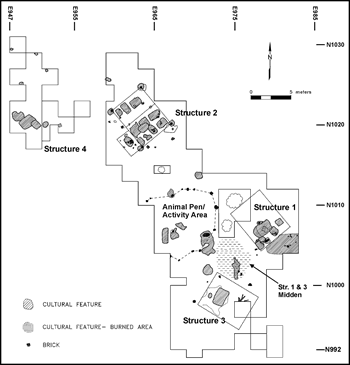Field Findings

Excavations at Site 44JC969 identified four structures, representing dwellings for the enslaved occupants of the quarter. As none of the structures are clearly delineated on Desandrouins' 1781 map, they were outlying buildings within Southall's Quarter or plantation that housed slaves. By contrast, the larger size and clustering of buildings shown in the center of the open area labeled as "Southall's Quarter" appear to symbolize the main domestic complex of the plantation, which records suggest was likely occupied by an overseer during Southall's ownership.
Within Site 44JC969, all structures but Structure 3 share the same orientation. A fenced area that may represent a small animal pen contains several shallow, amorphous features and is centrally located between Structures 2 and 4 to the northwest and Structures 1 and 3 to the southeast. At least one building is of earthfast construction with an attached shed, while two others are probably of log construction. Structure 3 is unique in the fact that it is much less visible in the archaeological remains as a discrete structural area, suggesting that it was occupied less intensively or for a shorter duration than the other structures. All four dwellings are located on the edge of a broad ridgetop overlooking the deep ravine to the west, which reflects a preference to place slave housing at the edge of a broad elevated open area as opposed to the highest elevations in the center of the open ridgetop.
The Cabins
By at least the mid-eighteenth century, most Chesapeake slaves lived in separate residences rather than dormitories, a change reflected by the four detached cabins in Southall's Quarter. The mixed styles of construction represented by the individual cabins stand in contrast to many large plantations in which the components conformed to a particular regional model. For example, Kingsmill area quarters were of earthfast construction (with wooden support posts sunk into the soil), while quarters at Monticello's Mulberry Row were log quarters with earth floors. Artifacts recovered from Site 44JC969 indicate that the main period of occupation occurred from the mid-eighteenth century to around 1800, with abandonment roughly coinciding with the death of James Southall.














